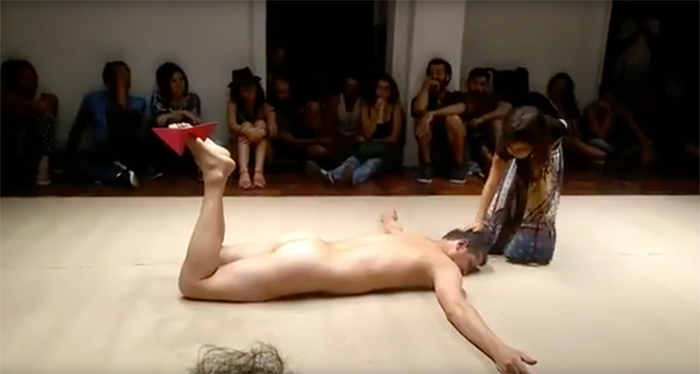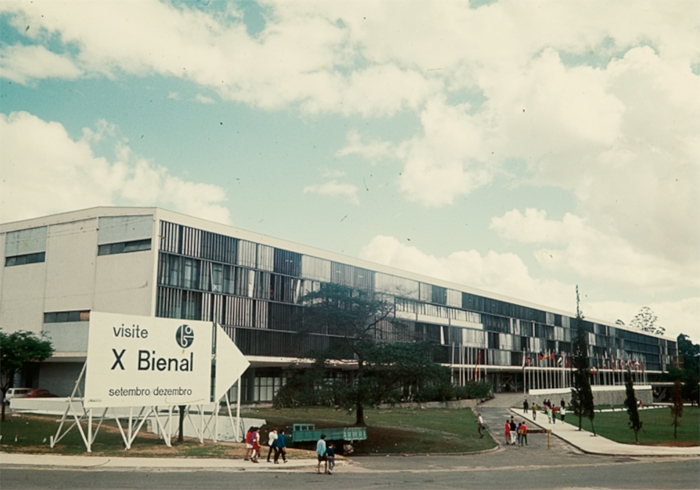In 1967, on the eve of the opening of the 9th Bienal de São Paulo, police entered the Ciccillo Matarazzo Pavilion in Ibirapuera Parque and removed a box sculpture by Cybele Varela, inside of which was a map of Brazil and a picture of a military general, and a series of paintings by Quissak Jr that featured the Brazilian flag. Both were deemed unpatriotic; both were eventually destroyed. Varela was questioned by the DOPS, the secret police, narrowly avoiding arrest. The move by Brazil’s military government, then in its infancy, caused an outcry in the local press. Three years prior, generals from the army and navy (with a nod from the CIA) had overthrown the democratically elected government of João Goulart, and the incursion on the biennial was a small but early sign of how increasingly despotic the regime would become. By the end of 1968 censorship had become enshrined in the constitution through Institutional Act n. 5 (the most infamous of 17 such decrees that were issued by the military dictatorship, overruling the constitution and denying any recourse to judicial review), and in December, the month this new edict was delivered, authorities stormed the Bienal de Bahia to remove work deemed politically offensive or immoral. In May the following year police closed down an exhibition at the Museum of Modern Art of Rio de Janeiro, which was showing selected works from the 6th Biennale de Jeunes in Paris, deeming the art overly erotic in nature. The curators of the 1969 edition of São Paulo’s biennial were warned in writing that there would be trouble if they showed anything the regime deemed unacceptable: with many of Brazil’s artists now in exile, word spread internationally, and over 80 percent of the artists invited, both Brazilian and international, refused to take part in the tenth edition. The Brazilian association of art critics went on strike around the same time, and by 1970 the American curator Kynaston McShine (who died earlier this year) was lamenting, ‘If you are an artist in Brazil, you know at least one friend who is being tortured’. In August, Pablo Picasso, Henry Moore and other international luminaries wrote an open letter protesting an arrest warrant issued for the critic Mário Pedrosa.
This historic attack on artistic rights was the canary in the coal mine for the far greater crimes committed by the regime afterwards. Institutional Act n. 5 ushered in the so-called Years of Lead. Congress was disbanded and arbitrary arrests, imprisonment without trial, kidnapping and torture (which included rape and castration) dramatically increased.
This year’s edition of the biennial comes at a particularly nervous time for liberal and/or left-leaning citizens of Brazil (to which politics the majority of the country’s artworld subscribes). The past two years have seen a resurgence in rightwing activism, the latest wave of which has repeatedly targeted the country’s art scenes, in part emboldened by the impeachment of Dilma Rousse and the new presidency of conservative Michel Temer. In October, artist Wagner Schwartz was forced to flee the country after threats on his life following a nude performance, that took place at the MAM de São Paulo. The work, La Bête (2017), called for audience participation, and Schwartz caught the attention of social conservatives (particularly members of the Movimento Brasil Livre, a rightwing pressure group run by charismatic twenty-two- year-old Kim Kataguiri) after an online video documented the presence of children among the crowd. When it was picketed by conservative and religious activists in October, Santander Cultural closed Queermuseu: Cartogra as da Diferença na Arte Brasileira, an exhibition at the bank’s cultural centre in Porto Alegre that surveyed work by the country’s LGBT artists. In November a crowd gathered outside a lecture given by Judith Butler and burned an effigy of the American theorist. It is in this climate, which exists alongside Operation Car Wash, a massive corruption scandal that has led to indictments of politicians from all parties, and rising inequality as the economy tumbles, that the country will go to the polls on 7 October for a general election (exactly a month after the doors to the biennial pavilion open). With former president Luiz Inácio Lula da Silva in prison for corruption (but still running for election), Jair Bolsonaro, a candidate on the far right, is predicted to pick up between 19 and 22 percent of the votes, making him a favourite for the highest office (Temer, whose popularity is at an unprecedented low, ruled himself out of the race in February). Last year the controversy surrounding Queermuseu was brought up on a talkshow on which Bolsonaro appeared. Repeating his point three times, the candidate said he thought it “necessary to shoot” those involved in the exhibition.

Bolsonaro is a politician who knows how to gain and game attention (in August his son was photographed meeting Steve Bannon in New York, and there is a suggestion that he might hold Donald Trump as a role model in this respect). He definitely plans to disband the Ministry of Culture, moving some of its responsibilities to the education department. At a campaign meeting in Curitiba, in front of 2,000 supporters, many uniformed and armed, he railed against “big-time artists” and promised to reform the Rouanet Law, through which companies can pay some of their taxes into cultural initiatives, a mechanism without which most of Brazil’s public museums and theatres are unlikely to survive. This is a minor worry, of course, compared to what else a Bolsonaro presidency might bring. The politician has claimed Portuguese slave-traders “never set foot in Africa” and has vowed to cancel a affirmative-action laws designed to help black and indigenous Brazilians in a country that is already racially divided. He is antiabortion, anti-gay rights and in favour of loosening gun-control laws. In August he appointed Antônio Hamilton Mourão as his running mate, an army general who has previously claimed the military should seize power if Brazil’s courts do not root out corruption or deal with a murder rate that in 2017 was the highest ever recorded in the country.
In his statements trailing this year’s biennial, the curator of the 2018 edition, Gabriel Pérez-Barreiro, the director of the New York and Caracas-based Colección Patricia Phelps de Cisneros, has eschewed direct commentary on Brazil’s politics, although he does note that he hopes the show will investigate ideas of ‘presence, attention and the way that the environment influences our experience’. What is obvious however is his desire to widen the conversation beyond the domestic situation, with the Spaniard inviting five international artists – Alejandro Cesarco (born in Uruguay), Antonio Ballester Moreno (Spain), Claudia Fontes (Argentina), Mamma Andersson (Sweden) and Wura-Natasha Ogunji (US) – as well as Brazilians Waltércio Caldas and Sofia Borges to each curate their own mini-exhibition under the biennial title Affective Affinities. There is no reason why Pérez-Barreiro should necessarily engage in local politics, and indeed the exhibition might prove a welcome respite for its domestic visitors during an intense time for the Brazilian public (Ariane Roder, a political scientist at the Rio de Janeiro Federal University’s business school told Bloomberg News that, for whoever won the presidential election, ‘bringing calm to society will be the challenge’).
It will however be a biennial whose success is to be measured, at least in Brazil, against the backdrop of the country’s current troubles. You might deem it naive to think, in times of trouble, that art, however political its message, can be anything but the victim of autocratic regimes, but the Bienal de São Paulo is not a niche affair: the 2016 edition saw a footfall of 900,000; it is the second oldest biennial in the world and commands international attention. These factors give it a certain amount of power. Pérez-Barreiro’s exhibition should not illustrate the news, but it could offer a space in which the artworld, both at home and abroad, can prepare for battles ahead. Much work has already been done. Artists, gallerists and curators from the country issued an open letter in October last year calling on ‘all democratic forces’ to mobilise against the looming threats to social and cultural freedom ‘in the streets, in the legislative houses, in the courts of justice and in all the available means of communication’. The biennial offers one such platform for action.
Writing in 1973, recalling Brazil’s first dictatorship under Getúlio Vargas during the 1930s and 40s, Mário Pedrosa wrote: ‘A tepid mood set in. The monotonous, suffocating days of the dictatorship were prolonged. Exhibitions of this or that by greater or lesser talents opened and closed, only to disappear without leaving behind so much as an echo.’ Pedrosa’s point was that there are moments at which the types of exhibitions we are making matter more than they do at others. Not even necessarily for the present, but for the art history of the future.
The 33rd Bienal de São Paulo: Affective Affinities runs from 7 September to 9 December 2018 at the Ciccillo Matarazzo Pavilion, Ibirapuera Park
From the September 2018 issue of ArtReview
